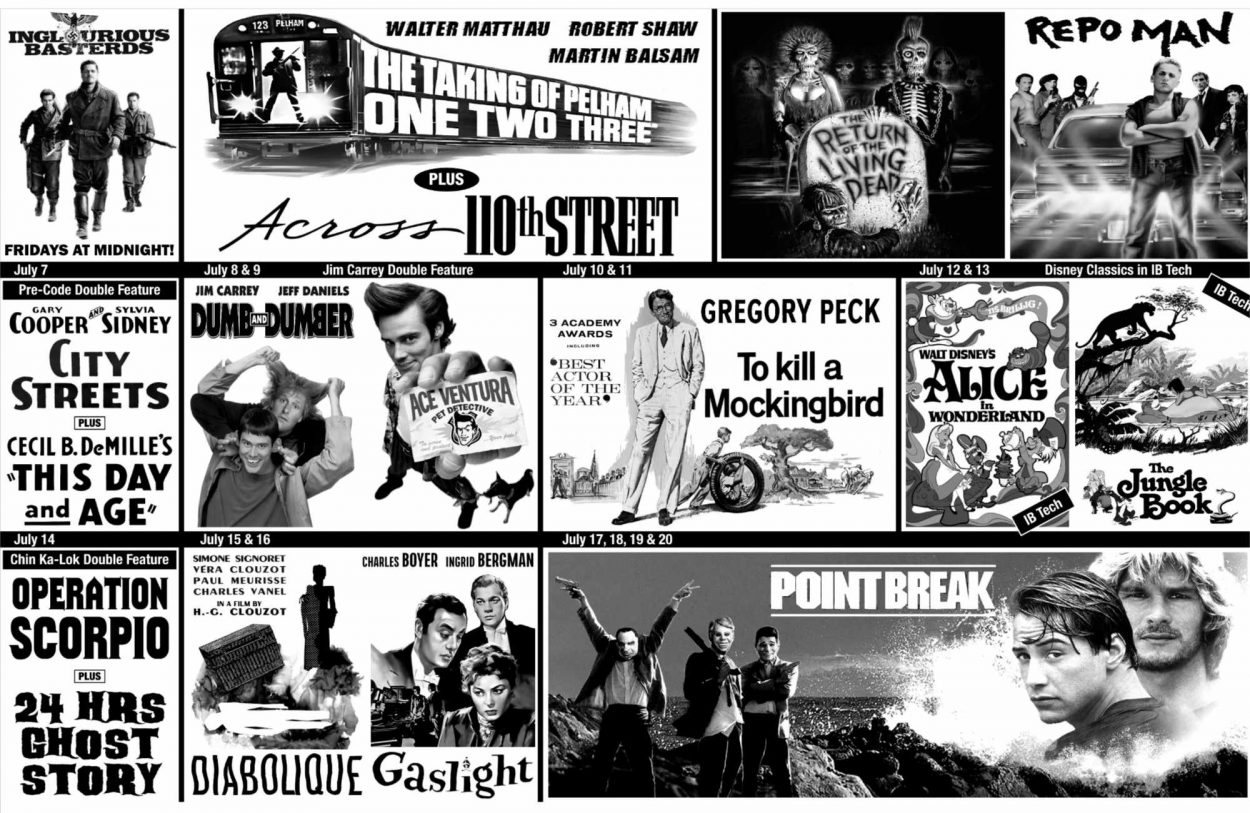“There’s Mr. Sawyer. He’s contemptible, dishonest, selfish, deceitful, vicious … Yet he’s out there and I’m in here. He’s called normal and I’m not. Well, if that’s normal, I don’t want it.” – Kris Kringle
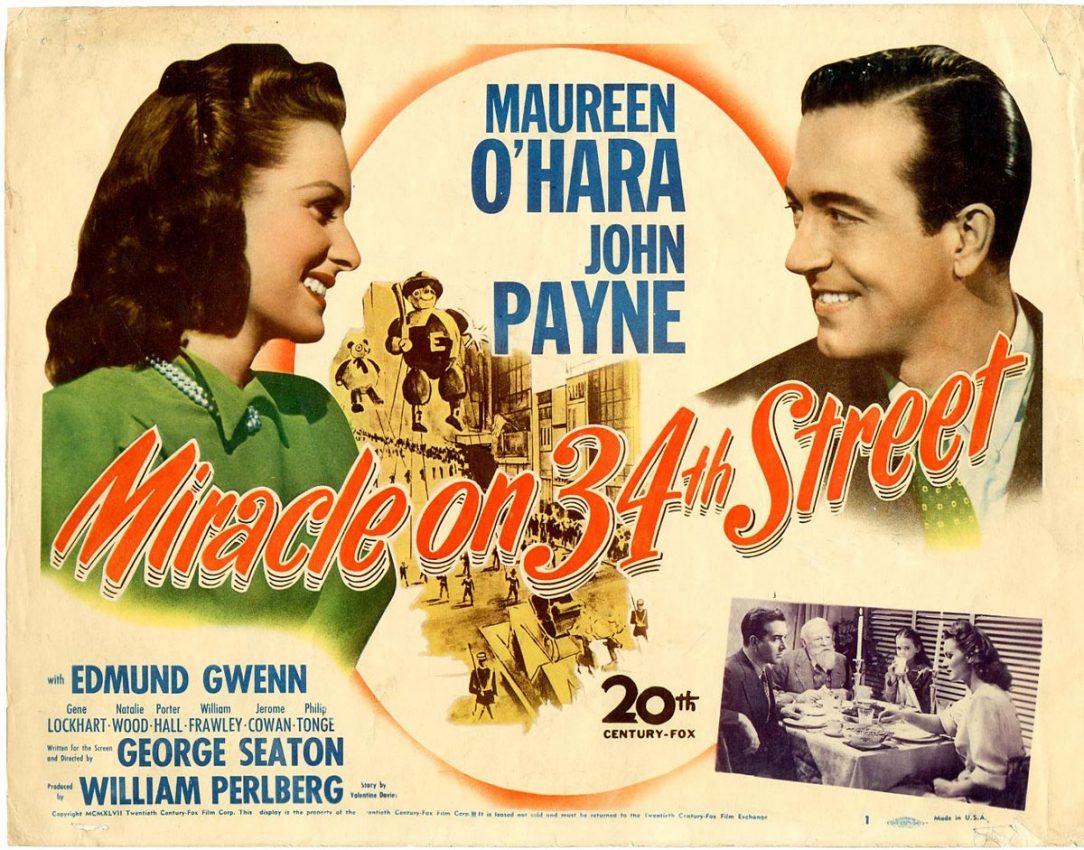
Is Santa Claus insane? That’s what Miracle on 34th Street asks and never really answers. Not really. Santa is cleared in court and certainly not dangerously delusional and there’s a strong suggestion that he might really be Santa, though I never bought it. No way. I don’t care what people who love this movie say (and I love this movie). Kris Kringle, who lives in an Old Folk’s Home where no elves are to be seen, with no Mrs. Claus nearby (as far as we can see), a guy who takes the subway into the city, is wonderfully, sweetly nuts, that’s my take, and that’s what makes me like the movie even more. The beloved George Seaton classic gives you room to ponder Santa’s mental stability and think further about the white-bearded fellow – the figure of myth, of commercialism, of the shrewd business and competition of department stores (in this case, Macy’s and Gimbels), courts, greedy kids and nice kids and awful parents and frazzled parents and then, the common-sense parents. Almost progressive common sense – like Doris Walker, the mother Maureen O’Hara plays – a movie-mother I always liked, even if the film wishes she would stop being so sensible. But who can blame her pragmatism? It’s 1947, she’s divorced, living in New York City, working hard at Macy’s as an event director and raising her kid alone. She certainly doesn’t believe in Prince Charming or Santa Claus and probably not God either, and she doesn’t want her child to buy into mythology or malarkey that will only let her down. I always loved her character and I loved her daughter Suzie, played by the natural, intelligent Natalie Wood. I understood Suzie’s initial side-eye of the man who keeps saying he’s the real deal Santa Claus, softened by her sweet notice of what a good job he’s doing. When he tells the little girl he’s actually Santa Claus, she knows the score: “My mother’s Mrs. Walker, the lady who hired you,” she says. And then, nicely, she adds, “But I must say, you’re the best one I’ve seen.” Already, she likes the myth of Santa, and she likes Gwenn’s real beard, his gentle, though different demeanor. What is so different about him? You see young Natalie Wood wondering this so convincingly. Well, for one, that he seems so real. Is she starting to believe? And, again, she likes this man. After all, he’s Edmund Gwenn as Kris Kringle, a gentleman so charming and sparkly-eyed and lovely and interestingly real (he opens the film walking the streets of New York City in an impressively long location shot, giving the picture an almost gritty feel), that he’s impossible not to love, even if he’s a bit pushy in the matchmaking department.
And he’s not a drunk (poor guy – he’s cold – “A man’s got to do something to keep warm.”) like the other Santa Suzie’s mom had to fire from the Macy’s Day Parade. That sad drunk we actually feel sorry for is played by the great Percy Helton – Percy Helton! The lech who leads to Beverly Michaels’ downfall in Wicked Woman, that worm! Edmund Gwenn is on to him right away, and any kid would be too. I mean, did we really believe in Santa? Deep down? What if you caught mommy kissing Percy Helton underneath the mistletoe? Or rather, Percy Helton kissing mommy? Shove him off of her! Call the cops! That’s not Santa.
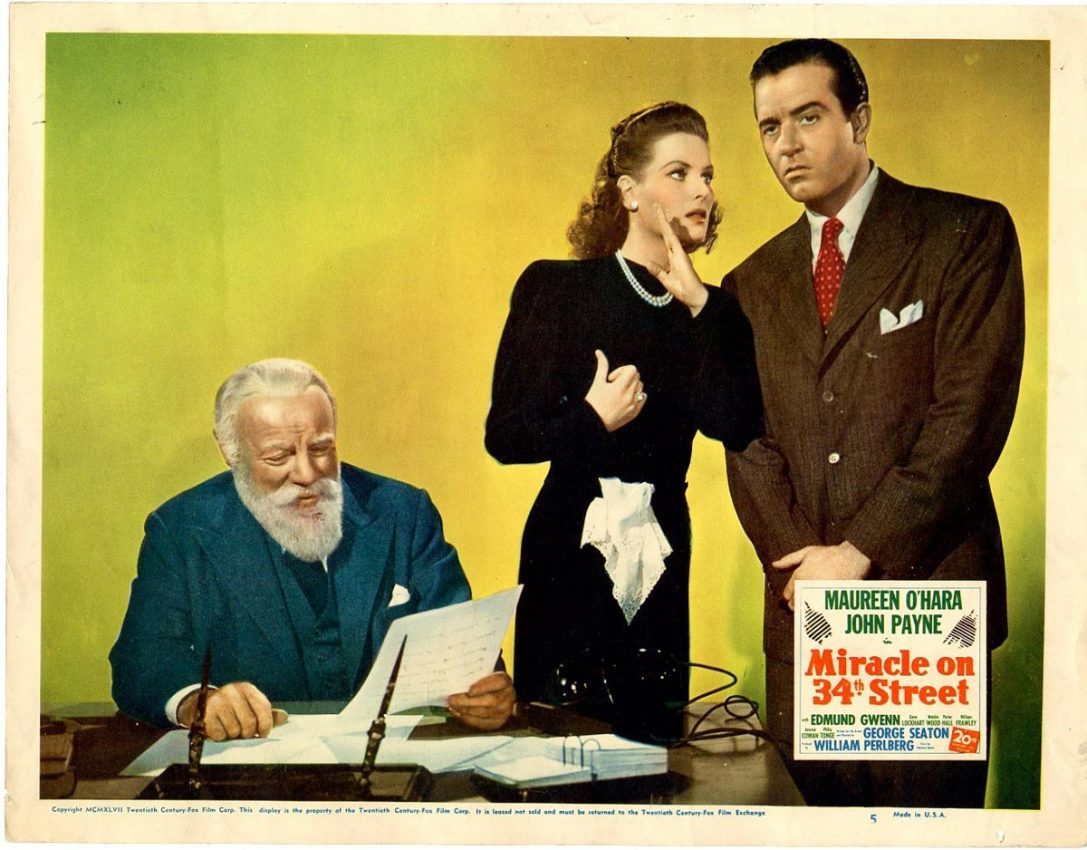
I was six when I learned there was no Santa Claus. I had my suspicions earlier, for I was a somewhat sensible child, and I was a wary child, but I wanted to believe in that man – I liked the idea of Santa (and this is the American, post Coca-Cola version of Santa) with his white beard, his red suit, those reindeer and their sing-songy names. And, of course, presents, and his snowy outpost where he made them (which I never believed). I loved Rudolph and his red-red nose and I was curious about elves, even if they creeped me out a little, and I admired the whole sliding down the chimney athleticism of the big guy. (But what if you didn’t have a chimney? I guess he came in through a window, I thought. Maybe through the bathroom window – as the Beatles sang.) But I was growing up, and six is not five, that’s a big step, and these figures of folklore took on an absurd, sometimes sinister edge, which made them both not believable and intriguing; weird, or wonderful. I loved fairy tales for that reason, and devoured all of the real Brothers Grimm, intertwining those stories with the holiday creatures, wondering if they might have darker sides as well. The Easter Bunny then became something like the Big Bad Wolf. That once delightful bunny became a chilling monster for an evening after my sister woke me up in the middle of the night when I was five, informing me that an enraged rabbit was trying to break into the house because mom locked all the doors. She said he was loitering outside and would probably bust through the door with an ax. Would he eat us? I didn’t want him to come in. The next morning, finally understanding she was joking (I love my sister), I was resolute to not believe in that enormous rabbit anymore because essentially, this big bunny was a home invader, and while my sister was messing with my belief in a tough love, darkly humorous Night of the Lepus kind of way (wise up, kid, a rabbit jumping into your house could KILL YOU) I understood he’s better considered as a mythic creature.
And so, I had to come to terms with Santa. He, too, sneaks (breaks) into your house in the middle of the night. He gives you the cold shoulder if you’ve been “naughty” (or puts coal in your stocking – or worse, in other cultures). So, the truth. I learned what that was all about when an older neighbor kid told me there was no such thing as Santa Claus. And I was mad. I argued, probably stomping my feet, insisting, “Yes, he is real!” But the kid said, “Don’t be a baby! He is not real. How do you think he can get all that stuff all over the world? You’re being really dumb.” I was standing there simmering – all seething six-year-old rage – a don’t-you-call-me-dumb stare-down. It was very dramatic to me. And yet, inside I thought, The Easter Bunny, he’s not real, that silly Tooth Fairy (what the hell does he do with kid’s teeth anyway?), Oh, god, I am dumb! He’s right. How could I believe this? I marched home and took my mother aside for a serious discussion about this revelation. I came to the conclusion that I was being lied to. She waved it off with an, “Oh, this is tradition! It’s just fun. OK, so, now you know.” A little like Maureen O’ Hara’s Doris in Miracle, she almost seemed surprised that I held on to this outlandish belief. But I was annoyed. I wasn’t so much crestfallen that Santa wasn’t real, but that I was so gullible to ever think so, and that people are a bunch of liars. I calmed down and coolly stated my thoughts: “Not that you lied to me, but that I no longer believe you, has shaken me.” Well, I didn’t really say that, Friedrich Nietzsche did, but it was a less “shaken” variation of the sort. I would like to have heard Natalie Wood’s Suzie say that.
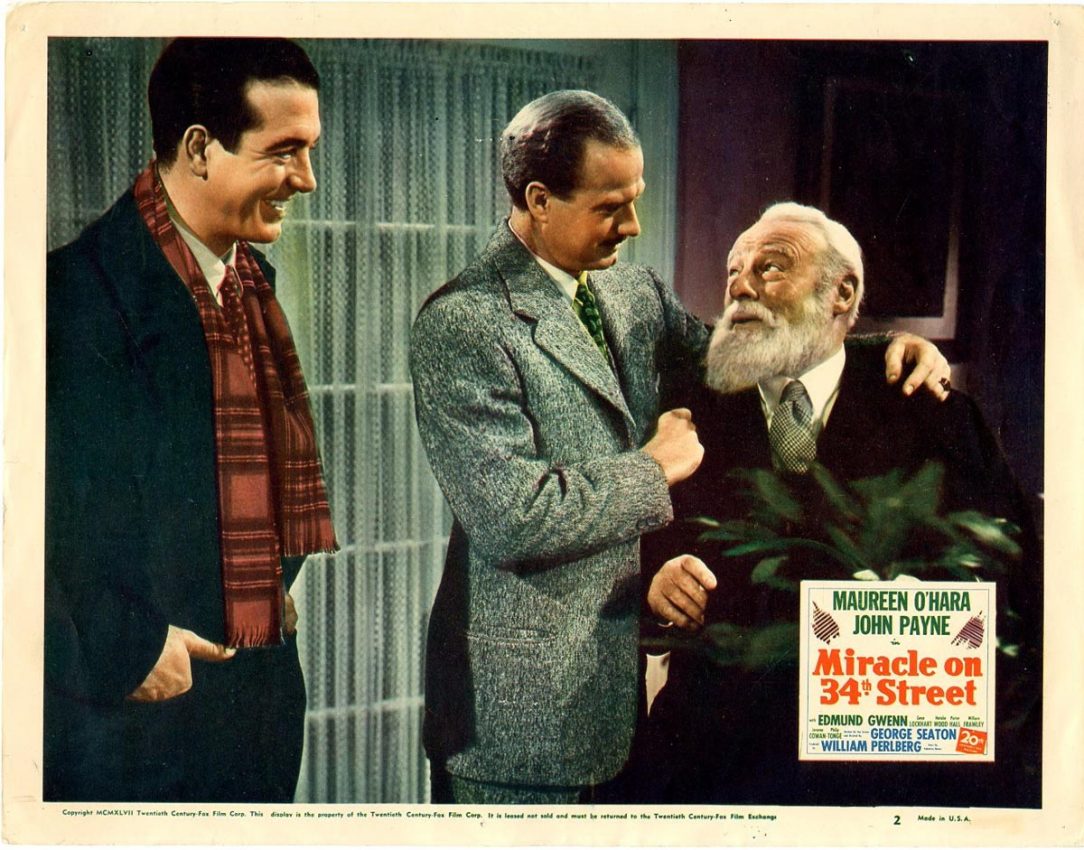
So you move on. Big deal. I thought, if a guy is pretending to be Santa, like Gwenn in Miracle, he’s either really sweet, or really creepy – which isn’t fair to all those guys who just want to work for a holiday season – and I don’t blame them for drinking – but I’m talking about being a six-year-old here. And, I thought, if you think you are Santa, like Gwenn, you’re probably nuts. But I was fine with nuts – create your own world, be whoever you want to be. It’s better than exhausted, fake Santa at the mall or drunk Percy Helton and his lap I will not sit on (I don’t think I ever did when I was a kid), even if exhausted, fake Santa became a source of amusement later in life. All forms of exhausted, drunk or deranged Santas became amusing and/or disturbing with an entire sub-genre of films to dig into what lies beneath that red suit. But before all of those Silent Night, Deadly Night movies or Santa-suited Christopher Plummer vs. Elliott Gould in Silent Partner, or Billy Bob Thornton being “Bad,” or Johnny Craig creating “…And All Through the House…” for EC Comics’ The Vault of Horror in 1954, people were aware of the delightful strangeness of Santa via Miracle on 34th Street. Like when young Alfred (Alvin Greenman) tells Gwenn’s Kris that the uptight pseudo-psychologist, Granville Sawyer (Porter Hall), has been assessing him as a special case, that he finds it odd for a 17-year-old wanting to play/be employed as Santa – which isn’t too outlandish to wonder about. But this supposed doctor is a spiteful know-it-all and even cruel. Kris thinks the man’s psychoanalyzing is scaring the kid. Underscoring how some are suspicious of a certain kind of fake Santa, even finding them creepy, but through a sweeping generalization, Alfred relays what Sawyer told him:
“He says guys who dress like Santa Claus, see, and give presents away, do it because when they was young they must have did something bad and they feel guilty about it. So now they do something they think is good to make up for it. It’s what he calls a guilt complex.”
Alfred goes on with what Sawyer is assessing deep inside this young man’s psyche. And it enrages Kris – which is curious. He’s really mad. Kris, not anti-psychiatry (a nice touch in the movie – he’s not against heads being examined, even when his will thoroughly be searched), demandingly asks Sawyer if he’s a licensed psychiatrist. Sawyer says it’s none of Kris’s business, but Kris presses on: “I have great respect for psychiatry, and great contempt for amateurs who go around practicing it.” And then it leads to Kris … knocking Sawyer on the head, infuriating the man (“When a delusion is challenged, the deluded is apt to become violent!”) – and this propels the courtroom drama of the film. Kris is freaking everyone out – he’s not fit to sit at Macy’s – even if the most perfect Santa on earth is pulling in good business. He didn’t really hurt Sawyer so much as hurt his pride (Kris is clearly more intelligent than Sawyer) and Sawyer is milking it, but what if he hits a customer? What if he hits a kid? It’s a valid concern (though more interested with business than anything else), but what’s so beautiful about Gwenn’s performance is that we never ever think he would do such a thing – we are on his side right away. We believe he believes he’s Santa and we believe in this actor. So when Santa is chucked in a car to be carted off to an insane asylum, it’s genuinely distressing (though I wish the picture had went even darker here – I was always hoping for one scene like The Snake Pit or Suddenly, Last Summer – Suddenly, Last Santa).
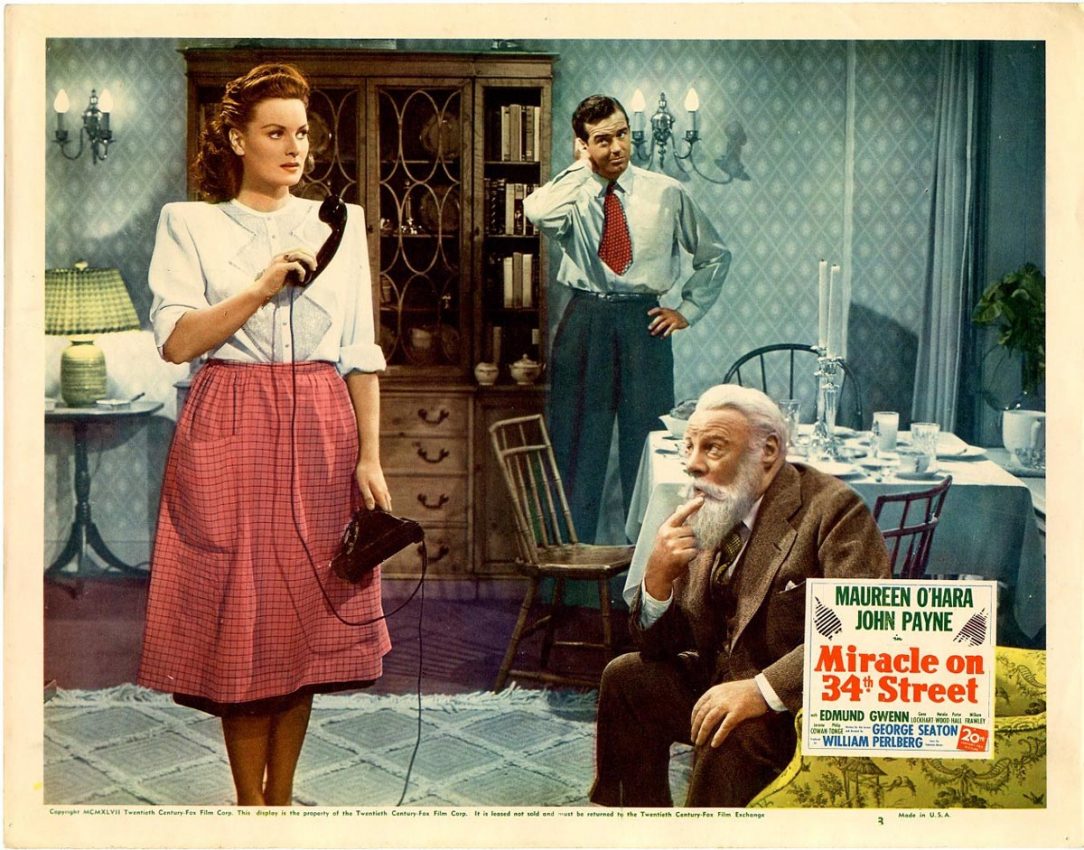
But Miracle on 34th Street is a family film, a picture that’s viewed by many as a lot of corn-pone Christmas cheer. I disagree – I always felt it expressed darker, more cynical tones (“All right, you go back and tell them that the New York State Supreme Court rules there’s no Santa Claus. It’s all over the papers. The kids read it and they don’t hang up their stockings. Now what happens to all the toys that are supposed to be in those stockings? Nobody buys them…”). The darkness/light balance is not quite at the level of Frank Capra, but the picture asks interesting questions and is genuinely different. A Christmas story to be sure, but also a down and almost dirty New York story (the cinematography by Lloyd Ahern and Charles Clarke is often very stark, sometimes noirish dark, and the Macy’s Day Parade sequence is beautiful). The sappy stuff never really soaked into me because it’s not really that sappy – Gwenn’s Santa isn’t just making people think of the true meaning of Christmas, but making people ponder just who should be deemed insane? Why can’t this old guy just believe what he believes? Be an eccentric? And then it also uses this old guy’s need to believe for manipulation – for business, for publicity, and for a lawyer (chiefly, Fred Gailey, played by John Payne) who is romantically interested in Doris Walker. He really does come to adore Kris, but he’s in love with Doris, and he’s not above using Kris and the ensuing drama to extra woo her. He’s sincere, but all of this Santa business is making him seem much more romantic. As he says: “Look Doris, someday you’re going to find that your way of facing this realistic world just doesn’t work. And when you do, don’t overlook those lovely intangibles. You’ll discover those are the only things that are worthwhile.”
Whenever Fred says this to her, I want to jump in and say, back off, buddy, allow Doris her “way of facing things.” Doris deserves some leeway given how many more challenges she’s surely had to face, certainly more than Fred. And she’s not wrong in wondering what is going on with this Kris Kringle – she’s got to think of safety – can’t have a psycho on her watch. But, thankfully, the movie never turns Doris into a shrew or a woman who must be tamed by the right man – even if Fred and Kris can get a little pushy. And she’s never cruel to Kris – she really becomes fond of him. Loves him, even. Doris is a smart, warm woman and she loves her kid – she rightfully doesn’t want Suzie to be hurt by fairy tales or some guy pretending to be Santa. But Suzie, sensible, cute Suzie – Suzie needs, well, a little crazy in her life. Fairy tales. For Doris, this is a sense of faith – not just in Kris or Fred but perhaps in men – and she likely needs that faith. And though faith could be interpreted as Doris finding a slight religious voice, she means faith in people, and so, not God or the Easter Bunny or Santa Claus (that’s how I choose to take this), but people. As she finally says near the end of the movie: “Faith is believing in things when common sense tells you not to.” That’s very sweet, but I like Kris’ take on imagination, which may even be an admission of himself. When little Suzie answers that imagination means seeing things that aren’t really there, he answers:
“No, to me the imagination is a place all by itself. A separate country … the first thing you’ve got to learn is how to pretend.”


